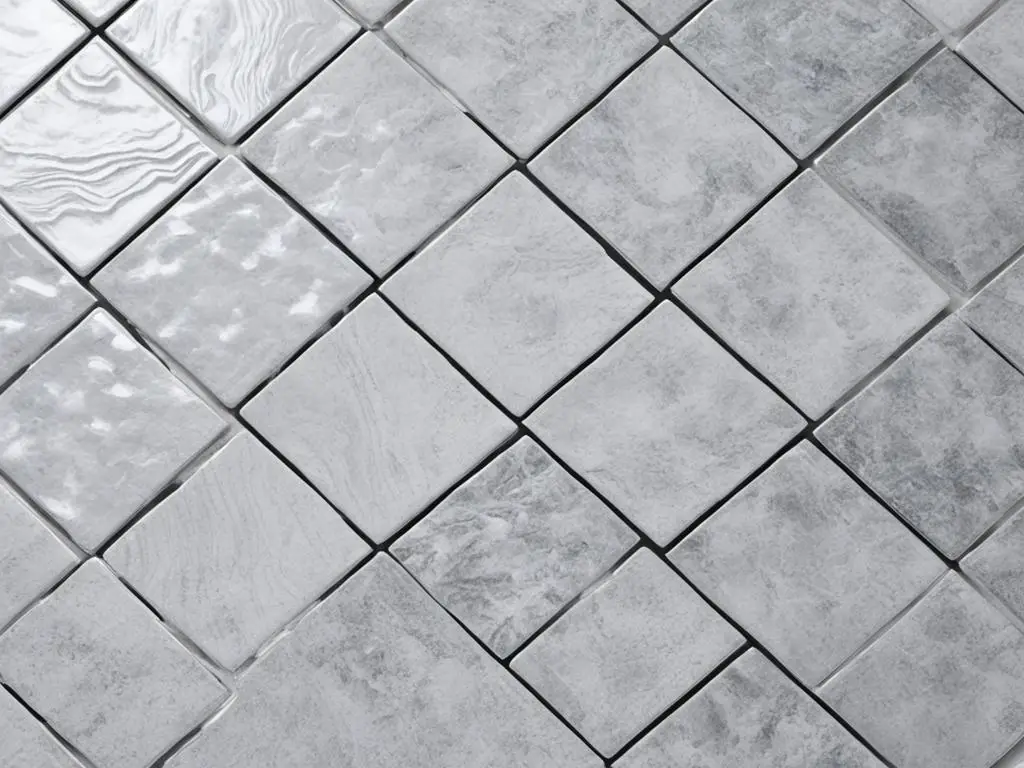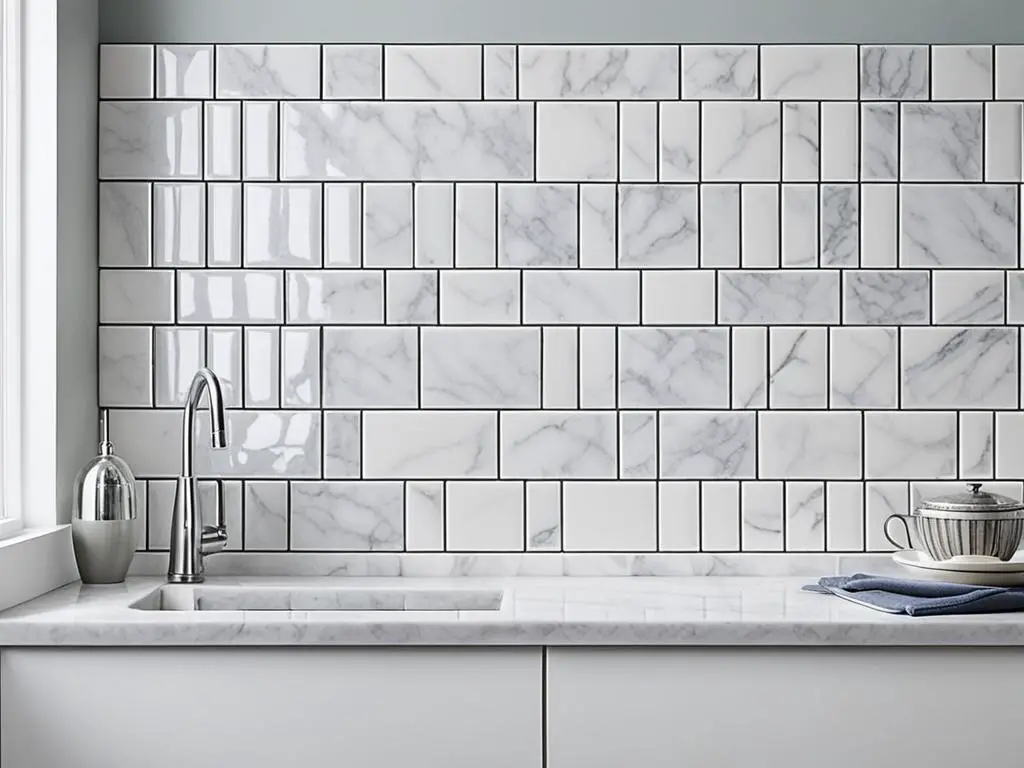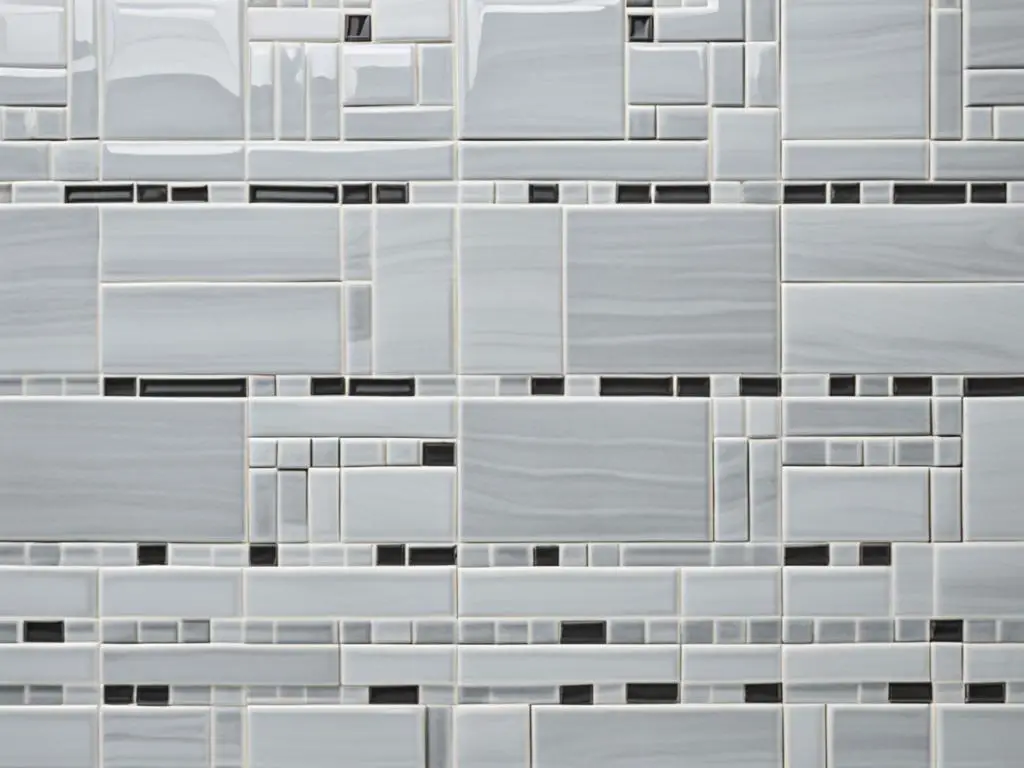When it comes to choosing the best grout for your tile installation, there are important considerations to keep in mind. One of the key factors is the shade of the grout, which can greatly impact the overall look and maintenance of your tiles. In this article, we will compare Cape Gray and Platinum Grout, two popular options in the market, to help you make an informed decision for your flooring project.
To determine the best grout color for your tiles, it’s crucial to assess the characteristics and appearance of the tiles themselves, as well as your design plan. Factors such as the type of tile, whether it’s patterned or solid-colored, and whether it’s made of natural stone or ceramic, can influence your grout color choice. Aesthetically, you can choose to blend in the grout for a uniform, monolithic look or contrast it to emphasize the tile pattern.
Key Takeaways:
- Consider the type and design of your tiles when choosing the grout color.
- Matching grout colors create a uniform, monolithic appearance, while contrasting grout colors highlight the tile pattern.
- Lighter grouts require more maintenance, while darker grouts can hide wear and stains.
- Test different grout colors on a sample board to see how they interact with your tiles.
- Choose a grout color that complements your overall design and aesthetic.
Factors to Consider When Choosing Grout Color
When selecting grout color for your tiles, it’s important to consider various factors that will help you make the best choice. The type of tile, whether it’s patterned or solid colored, the material of the tile (natural stone or ceramic), and the presence of mosaic sheets or accents can all influence your grout color decision.
For patterned tiles, contrasting grout colors can enhance the design and highlight different surface materials, creating a visually striking effect. On the other hand, for solid-colored tiles, matching grout colors can create a uniform and monolithic look, giving your space a sleek and seamless appearance.
Another important factor to consider when choosing grout color is the overall color scheme and layout of other surfaces in the room. You want to ensure that the grout color complements and harmonizes with the surrounding elements, creating a cohesive and aesthetically pleasing result.
In addition to aesthetics, the shade of grout can also impact maintenance. Lighter grout colors tend to show stains and dirt more easily, requiring more frequent cleaning to keep them looking pristine. On the other hand, darker grout colors are generally more resistant to wear and damage, making them a popular choice for high-traffic areas such as kitchens and bathrooms.
Remember: It’s always a good idea to test different grout colors before making your final decision. This will allow you to see how they interact with your tiles and how they look under different lighting conditions.
Expert Tip:
“When selecting grout color, take into consideration the overall design of the space and the desired visual impact. Contrasting grout colors can add depth and dimension to your tile installation, while matching grout colors create a seamless and unified look. Trust your instincts and choose a grout color that enhances the beauty of your tiles.”
Choosing the right grout color for your tiles is a crucial step in the overall design process. By considering factors such as tile type, material, color scheme, and maintenance needs, you can ensure that your grout color enhances the beauty of your tiles and complements your space perfectly.
Pros and Cons of Matching Grout Colors
Matching grout colors with the tile creates a uniform, monolithic appearance where the texture of the tile is more visible from a closer angle. This choice is forgiving of minor imperfections in tile placement and grout lines shaping. However, color variance in natural stone tiles may break the uniform look. Lighter-colored grouts require more maintenance to keep them looking clean, and any spots or stains are more noticeable. Stain-resistant grouts or sealing and maintaining cementitious grouts are recommended for lighter colors. Matching grout colors are commonly used for solid-colored tiles.
When matching the grout color with solid color tiles, it creates a uniform and seamless finish, enhancing the overall aesthetic. The grout lines blend in, allowing the tiles to take center stage and creating a visually cohesive appearance. Whether it’s a vibrant red or a classic white, matching grout colors highlight the beauty of the tiles and provide a clean and sophisticated look.
Matching grout colors offer a timeless appeal and a solid foundation for any tile installation project.
Despite its advantages, matching grout colors may have some considerations. In natural stone tiles, color variations are inherent, and when matched with the grout, these variations can break the uniform appearance. It’s essential to carefully select the grout color to complement the range of hues in the natural stone tiles.
Lighter-colored grouts, such as Cape Gray Grout, give solid-colored tiles a uniform and seamless appearance. However, they require regular cleaning and maintenance to keep them looking their best. Any spots or stains are more noticeable on lighter grouts, making them more challenging to clean. To overcome this, stain-resistant grouts or cementitious grouts that have been sealed and maintained regularly are recommended for lighter colors.
In summary, matching grout colors with solid color tiles can create a uniform and cohesive look. However, it’s important to consider the color variance in natural stone tiles and the maintenance required for lighter-colored grouts. By carefully selecting the right grout color and following proper maintenance practices, you can achieve a beautiful and long-lasting tile installation.

| Pros of Matching Grout Colors | Cons of Matching Grout Colors |
|---|---|
|
|
Pros and Cons of Contrasting Grout Colors
When it comes to tile installations, contrasting grout colors can add a unique touch to your design. Whether you’re working with a light-colored tile and want to create a bold statement or have a dark tile that needs a pop of contrast, choosing the right grout color can make all the difference.
Contrasting grout colors offer several benefits, including:
- Emphasizing the Tile Pattern: By selecting a contrasting grout color, you can highlight the intricate details and visible tile pattern. This can add depth and dimension to your installation, making it more visually appealing.
- Creating a Striking Look: Pairing a light-colored tile with dark grout or vice versa can create a dramatic, eye-catching effect. This contrast can make your tile stand out and become a focal point in the room.
- Expanding Design Options: Contrasting grout colors provide more design flexibility. You can create color themes between different surfaces or even accentuate different types of tiles within the same installation.
However, it’s important to consider the potential drawbacks of contrasting grout colors:
- Highlighting Layout Variations: While contrasting grout colors can enhance the tile pattern, they can also draw attention to any layout variations in the installation. If the tiles are not perfectly aligned, the contrast in grout colors may make these imperfections more noticeable.
- Careful Selection Required: Choosing the right contrasting grout color can be a challenge. It’s crucial to consider the overall design scheme, the colors of other surfaces in the room, and the desired aesthetic before making a final decision.
To help you visualize the impact of contrasting grout colors, here’s an example:
“The combination of a light gray subway tile with dark platinum grout creates a stunning visual effect. The distinct contrast between the tile and grout highlights the subway pattern, adding a touch of modern elegance to any space.”
– Emily Thompson, Interior Designer
Contrasting Grout Example:
| Tile Color | Grout Color | Visual Effect |
|---|---|---|
| Light Gray | Contrasts with the tile, highlighting the tile pattern | |
| Dark Gray | Creates a bold, dramatic look |
As you can see, contrasting grout colors can transform the appearance of your tile installation. Consider the atmosphere you want to create and the overall design scheme before selecting the perfect contrasting grout color.
Maintenance Considerations for Grout Colors
When it comes to maintaining the beauty and longevity of your tiled surfaces, the shade of grout you choose plays a crucial role. Understanding the maintenance requirements of different grout colors can help you make an informed decision. Here are some key considerations:
- Lighter-Colored Grouts: Lighter-colored grouts, such as whites and pastels, are easier to clean during installation. However, they require more maintenance to keep them looking clean and can show stains and dirt more easily. Regular cleaning and periodically sealing the grout can help maintain its appearance.
- Darker Grouts: Darker grouts, like grays and blacks, may be more difficult to clean due to their color intensity. However, they are less likely to show stains and wear on porous tile surfaces. Darker grouts are commonly used in commercial kitchens to minimize the visibility of stains. Pre-sealing the tile before grouting can help prevent staining and simplify maintenance.
It’s important to select grout options that are durable and suited to your specific needs. Pay attention to the manufacturer’s recommendations for maintenance and follow proper cleaning practices to ensure the longevity and attractiveness of your grout. Regular maintenance, such as sweeping and gentle cleaning, can go a long way in preserving the look of your tiled surfaces.
Expert Tip:
“Whether you opt for a lighter or darker grout color, proper sealing is essential to protect grout from moisture, stains, and discoloration. Be sure to consult with a professional or refer to the manufacturer’s instructions for the appropriate sealing products and techniques.”
Remember, choosing the right grout color is not just a matter of aesthetics but also practicality. Consider your lifestyle, the amount of foot traffic in the area, and your willingness to invest time and effort into maintenance. By selecting the right grout color and following proper maintenance practices, you can keep your grout looking fresh and extend the lifespan of your tiled surfaces.
Choosing Grout Color for Subway Tile and Marble
When it comes to selecting the perfect grout color for your subway tile or marble installation, careful consideration of the overall design and aesthetic is key. The right grout color can enhance the beauty of the tiles and create a cohesive look in your space. In this section, we will explore the best grout color options for subway tile and marble to help you make an informed decision.
Grout Color for Subway Tile
One popular choice for subway tile is pairing it with gray grout. The combination of white subway tile with gray grout creates a classic look that can complement any style of decor. When choosing the shade of gray grout, you have several beautiful options to consider.
Light gray grout: This option creates a subtle contrast with the white subway tile, providing a soft and elegant look. It can be a great choice if you want to achieve a more understated effect.
Dark gray grout: If you want to make a bolder statement and add more drama to your subway tile, dark gray grout is an excellent choice. It creates a stronger contrast and can make the individual tiles stand out.
Aside from the shade of gray, you can also choose between warm or cool tones depending on the surrounding colors and overall design theme of your space. Both options can create a visually appealing and harmonious look.
Grout Color for Marble
When it comes to marble, selecting the right grout color is essential to enhance the natural beauty and variations of the stone. Light to medium gray neutrals are popular choices that work well with most marble installations.
Polyblend Platinum and Delorean Gray are two popular grout colors that are known to complement both subway tile and marble. These shades of gray provide a neutral base that blends seamlessly with the natural tones and patterns of the marble.
Remember, the goal when choosing grout for marble is to create a cohesive look that enhances the overall appearance of the stone while allowing its unique characteristics to shine.
Take a look at the stunning examples below to see how subway tile with gray grout and marble with gray grout can transform your space:

Subway tile with gray grout and marble with gray grout can add elegance and sophistication to any room. The combination of these materials creates a timeless and visually striking look that can elevate the design of your space.
In the next section, we will discuss the importance of testing grout colors and how to make the final selection for your tile installation.
Testing Grout Colors and Final Selection
Before grouting a large area, it is advisable to create a sample board to test different grout colors and see how they look with the tile. This allows you to assess the final result and make an informed decision.
Apply the grout to the sample board and let it dry to see the true color. It’s essential to consider the color variations and lighting conditions in the room when making a final grout color selection. The ability to see how the grout color interacts with the tile can help ensure a satisfying outcome.
Testing grout colors on a sample board provides a visual representation of how the grout will appear when applied to the tile. This allows you to see the true color and make adjustments if needed. Additionally, it gives you the opportunity to assess how the grout color interacts with the tile’s texture and variations.
By testing different grout colors on a sample board, you can confidently choose the right grout color that enhances the overall look and feel of your tile installation.
Conclusion
When it comes to selecting the best grout color for your tile floors, the decision should be made with careful consideration. Factors such as the type of tile, desired aesthetic, and maintenance requirements should all be taken into account. Whether you choose to go with matching grout colors for a uniform look or contrasting grout colors to highlight the tile pattern, the goal is to enhance the appeal and durability of the space.
Lighter grout colors like Cape Gray can create a sleek and modern look, but they may require more maintenance to keep them looking clean. On the other hand, darker grout colors like Platinum can be more forgiving when it comes to wear and stains, making them a popular choice for high-traffic areas. Testing different grout colors on a sample board can help you visualize the final result and make an informed decision.
Ultimately, selecting the best grout color is a personal choice that should align with the overall design and aesthetic of the room. By taking into consideration the type of tile, maintenance requirements, and desired look, you can ensure that the grout color enhances the beauty of your tiles and complements the space.
FAQ
What factors should I consider when choosing grout color for my tiles?
Factors to consider include the type of tile (patterned or solid color), the material of the tile (natural stone or ceramic), the presence of mosaic sheets or accents, and the overall design plan.
What are the pros and cons of matching grout colors?
Matching grout colors create a uniform, monolithic appearance and can help hide minor imperfections in tile placement and grout lines. However, lighter-colored grouts require more maintenance to keep them looking clean and can show stains and dirt more easily.
What are the pros and cons of contrasting grout colors?
Contrasting grout colors can emphasize the tile pattern and make it more noticeable. They offer more design options and can help highlight different tile types. However, contrasting grout colors can also highlight any layout variations in the installation.
What should I consider regarding maintenance when choosing grout color?
Lighter-colored grouts are easier to clean during installation but require more maintenance to keep them looking clean and can show stains and dirt more easily. Darker grouts may be more difficult to clean initially but don’t show wear, dirt, or damage as easily.
What grout color should I choose for subway tile and marble?
White subway tile with gray grout is a classic look. Light or dark gray grout can be chosen based on the desired effect. When it comes to marble, choosing a grout color that blends with the natural variations of the stone is recommended, such as light to medium gray neutrals.
How can I test grout colors and make a final selection?
It is advisable to create a sample board and apply different grout colors to see how they look with the tile. This allows you to assess the final result and consider color variations and lighting conditions in the room when making a final grout color selection.
What is the best grout for flooring?
The best grout for flooring depends on factors such as the type of tile, overall design plan, and desired maintenance requirements. It is recommended to choose a durable grout option that suits the specific tile installation.
What are the advantages of Cape Gray and Platinum grout?
Cape Gray and Platinum grout offer a wide range of color options to suit any tile or stone installation. Their different shades can enhance the appeal and durability of flooring and other tile projects.
What is the difference between Cape Gray and Platinum grout?
Cape Gray and Platinum grout are two different shades of grout. The specific differences in color and appearance can vary depending on the brand. It is recommended to compare samples of Cape Gray and Platinum grout side by side to determine which shade best complements your tile or stone installation.




